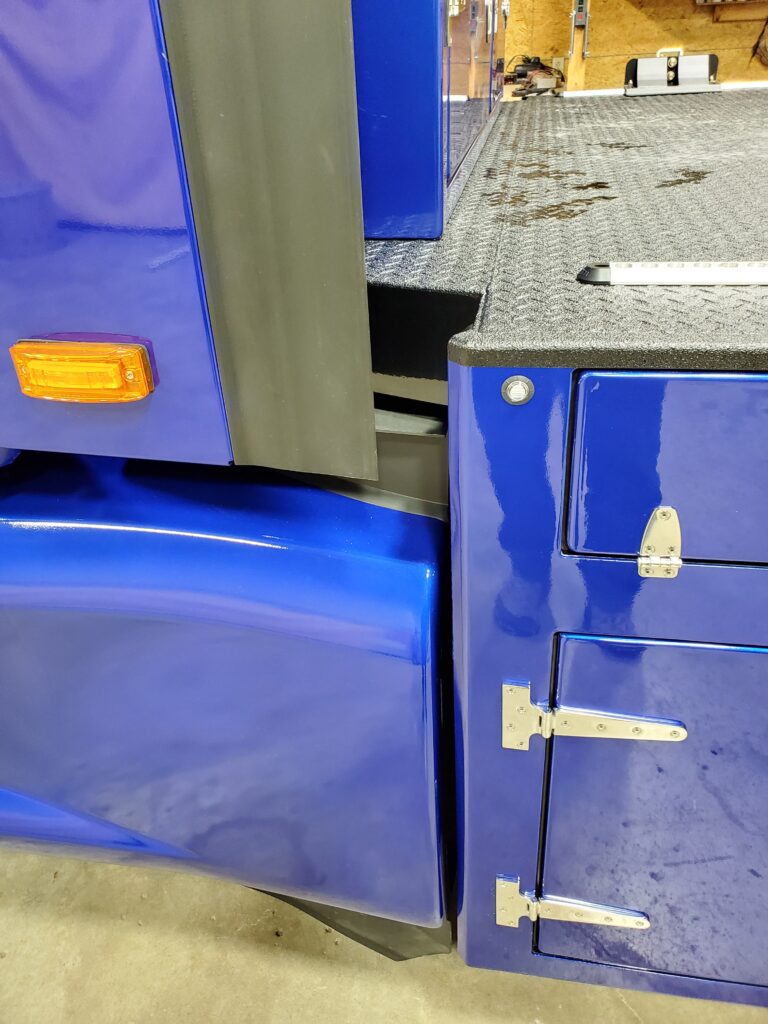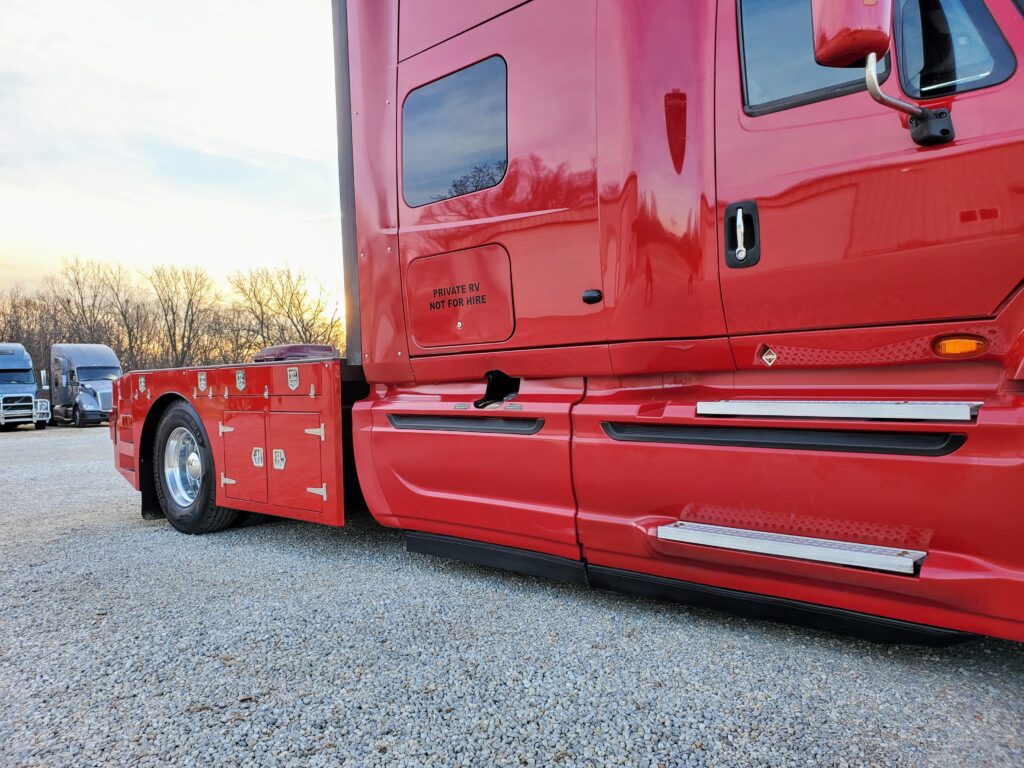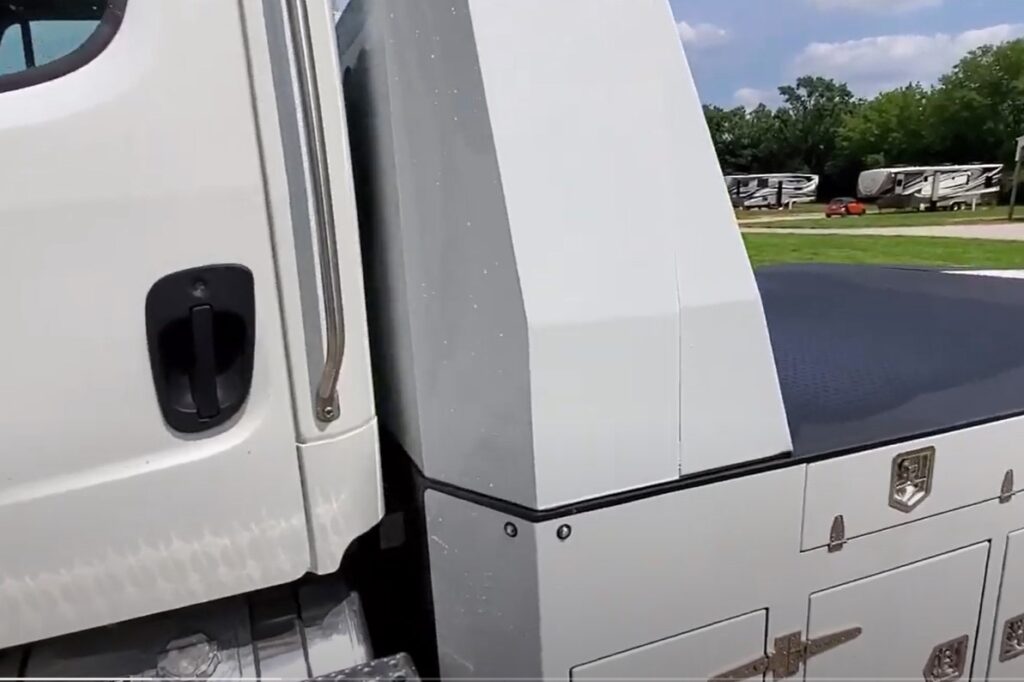Our flagship third generation hauler body provides the most advanced-concept body in the recreational heavy truck market. We built this body to maximize available storage, and to provide exceptional design elements, fit and finish.
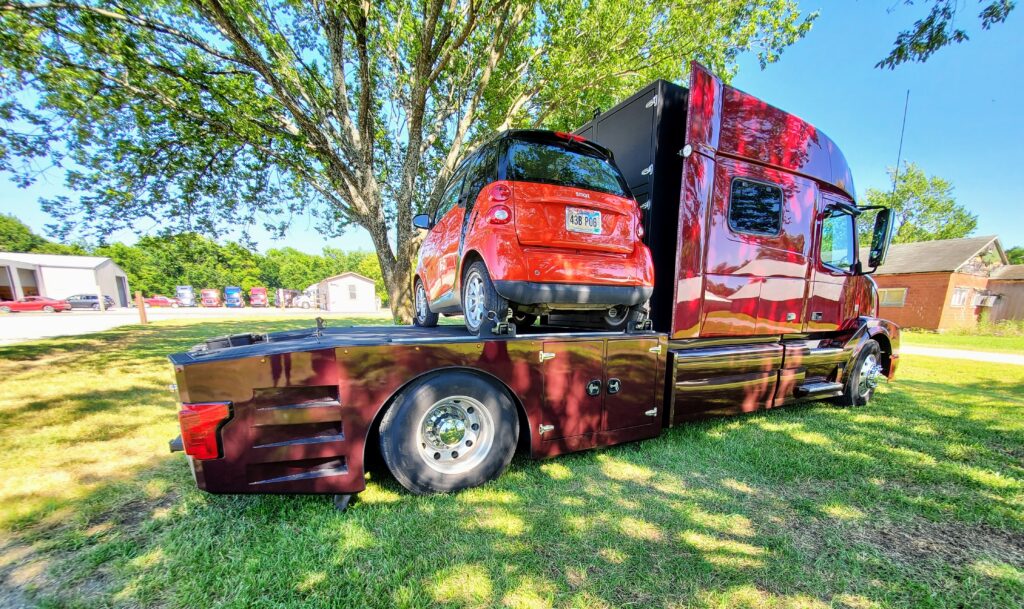
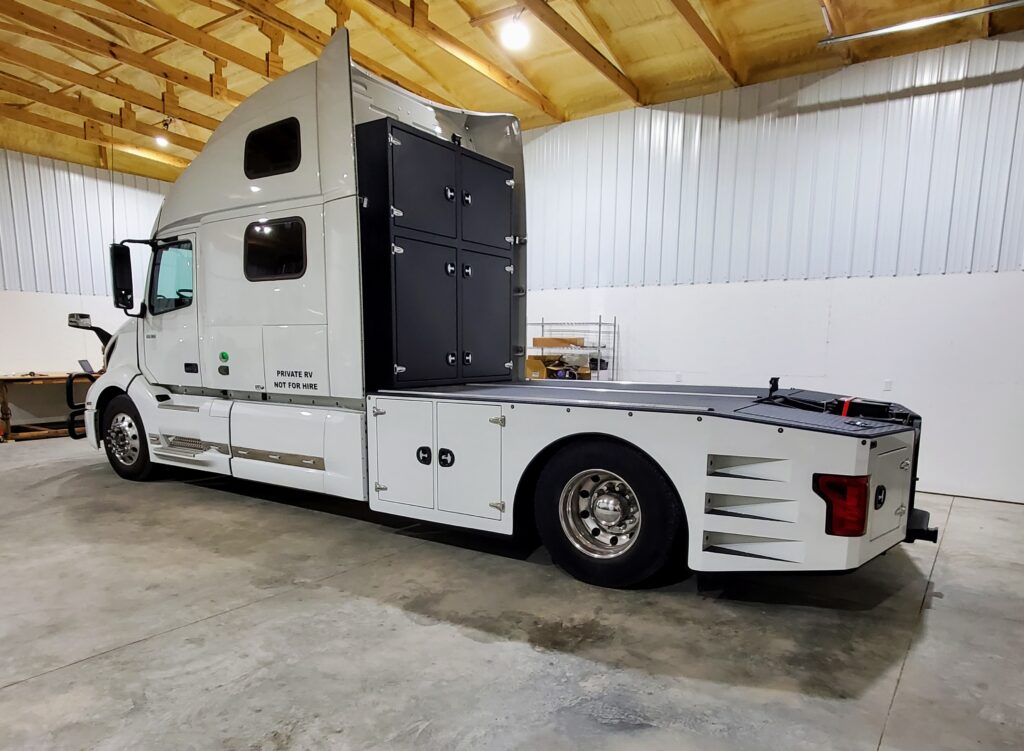
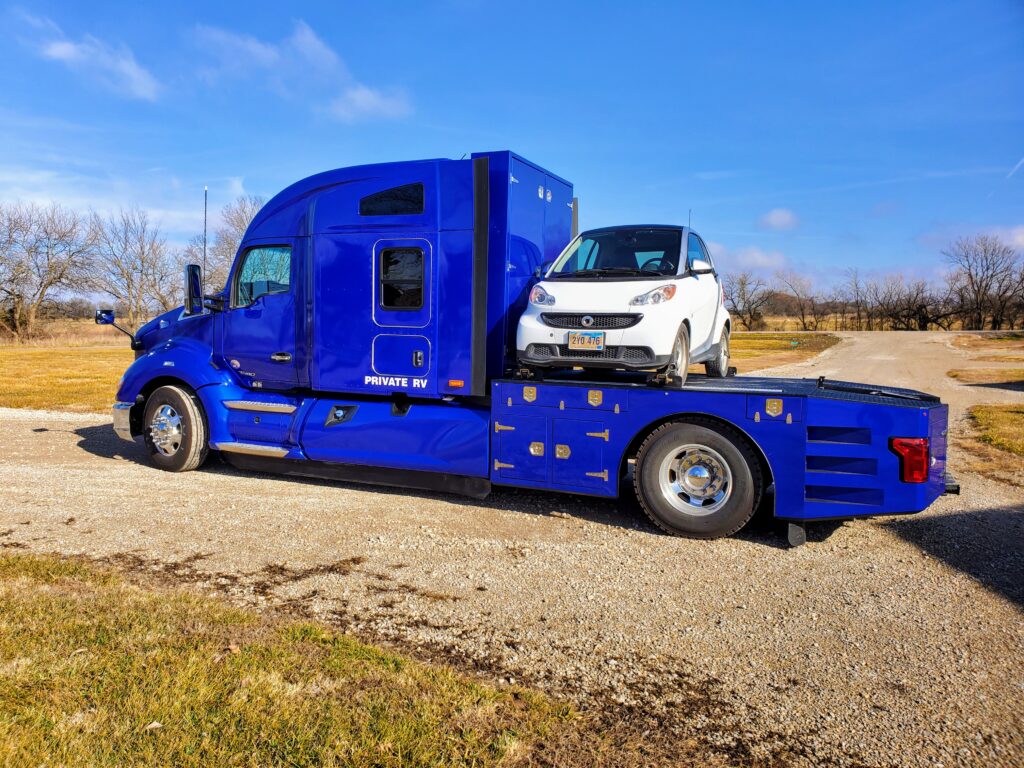
The premium body is a production body – meaning it is designed for a singled truck with a specific cab-to-axle dimension. We can single your existing truck to this dimension (99″ BOC to axle center line), or order a new truck with the required specifications. We do not customize the dimensions of this body, and most of the things that were options in the generation two body (gen2) are included with the third generation body (gen3).
The body is fully powder coated with a base primer powder coat, then a top coat – powder coat is applied to all accessible metal surfaces, including underneath the body and inside the boxes, etc.. We then body-work the bed to remove defects in the metal, block it, apply primer, block it again if necessary, and finally shoot topcoat. We use a two stage Axalta Cromax paint for the topcoat followed with clearcoat. Our objective is to get a near-automotive finish. Finally, we use Raptor bedliner on the top surface and rear utility panel. All paint and bodywork is done in-house in our state-of-the-art Cromax paint and body shop. We do not outsource paint – we find we get a better end product that way.
The bed is available for Volvo, Kenworth, International and Freightliner M2-series of trucks. Other brands/models would be suitable as well – although the ones listed are what we have done to-date.
The basic bed has four large boxes integrated into it – two double door boxes in front of the axle, and two single door boxes opening at the rear. These boxes are custom built to utilize all available space. The body also has the following features:
- Two large ramp storage areas.
- Structure to carry items in the defined cargo area – the forward bed section. While originally designed for a smart car, it can carry other items.
- Integrated steps at the rear that contain marker lights and allow access to the deck.
- Winch structural mounting points.
- Drom box structure.
- Frenched in Ford F150 tailights.
- DOT compliant lighting. With marker lights on the rear and sides of the bed.
- Bedlined on the top and rear.
- Class 5 hitch.
- Utility panel with space for three connectors (two trailer connectors and video) along with an airline quick connect (gladhands can be substituted if required).
- Floor liners in all boxes.
- High quality stainless hardware.
- Full-width mudflap that reduces debris striking the trailer.
- Whaletail storage on the top/rear of the bed.
- Under hitch storage with access from the rear utility plate.
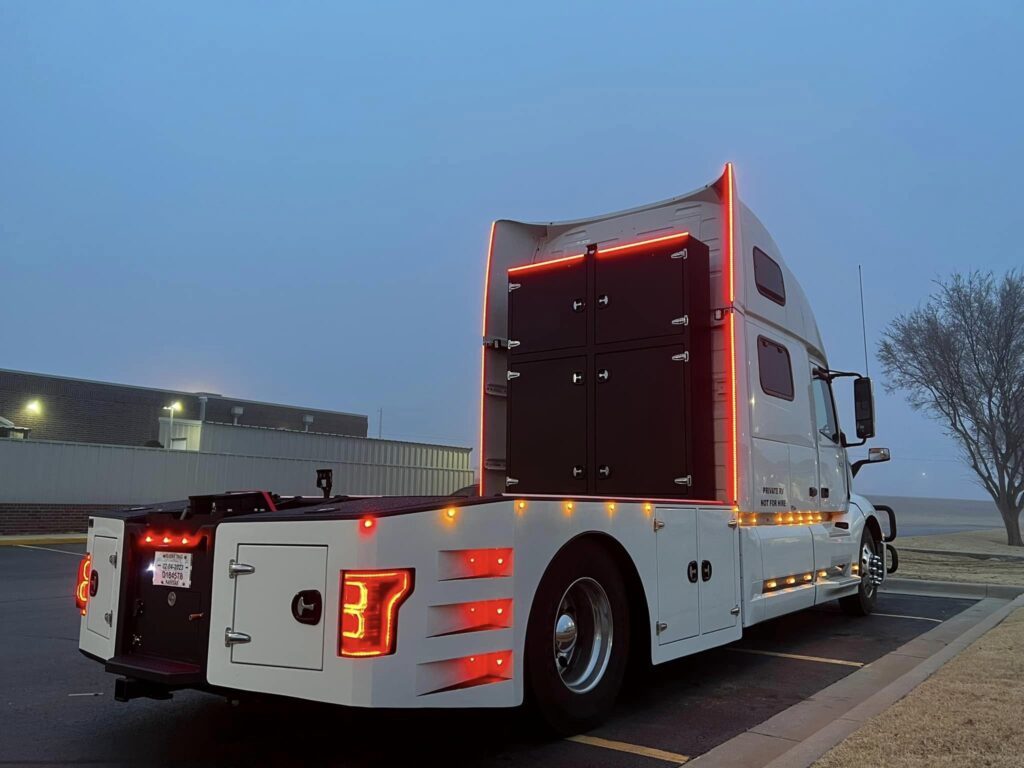
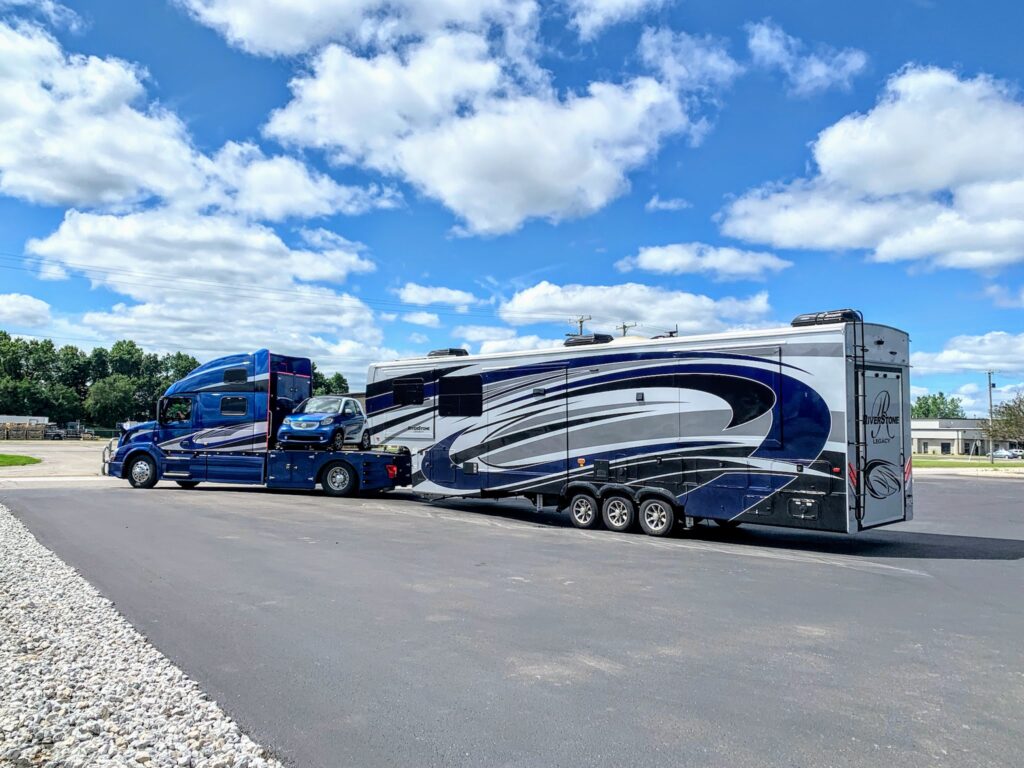
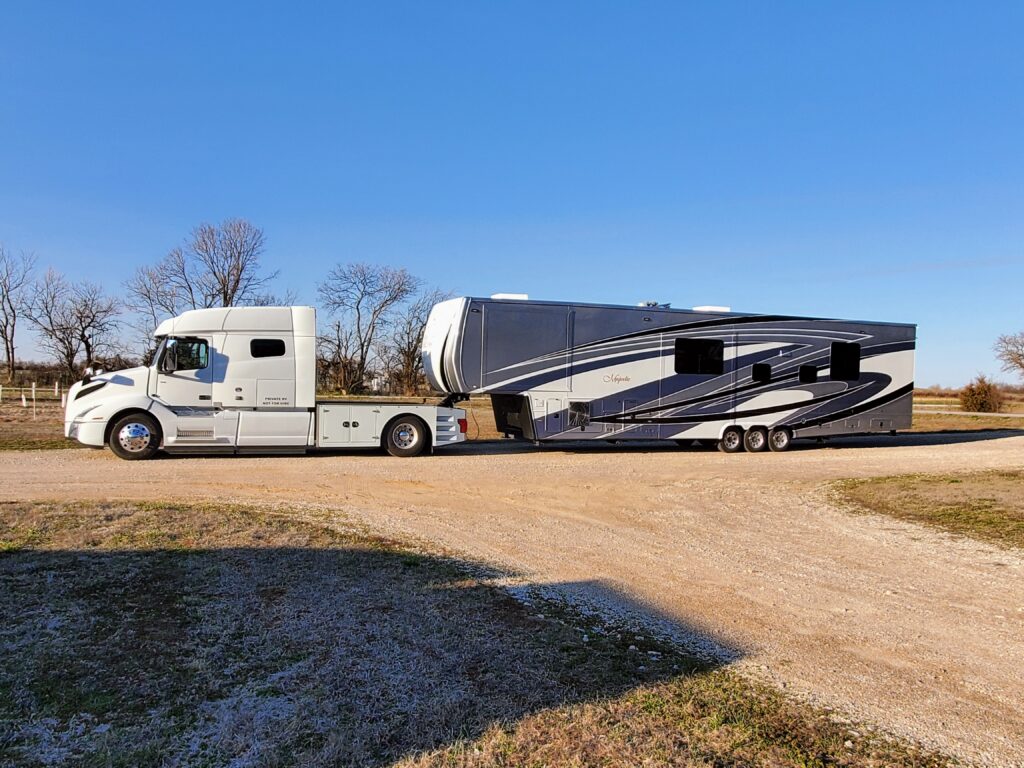
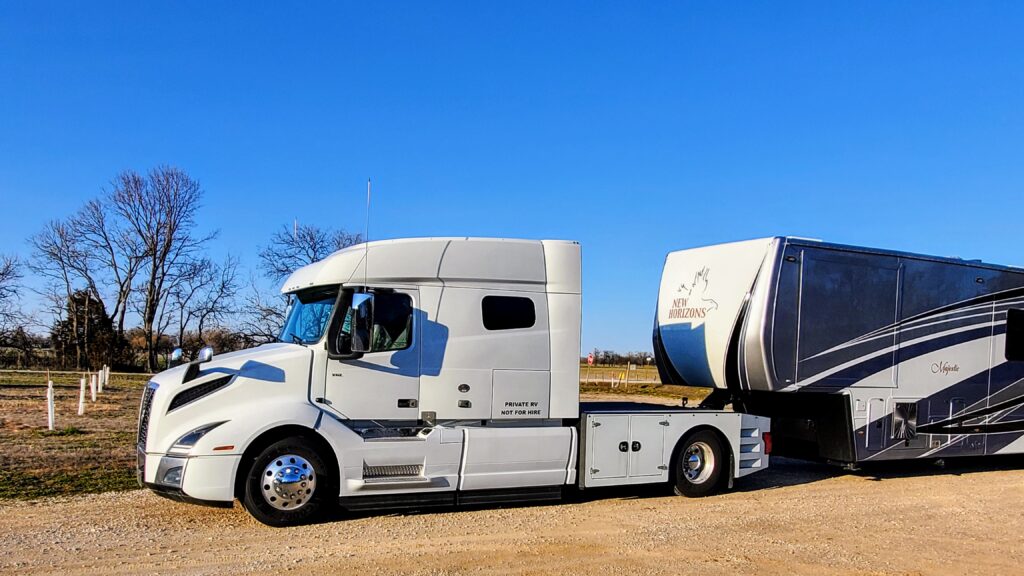
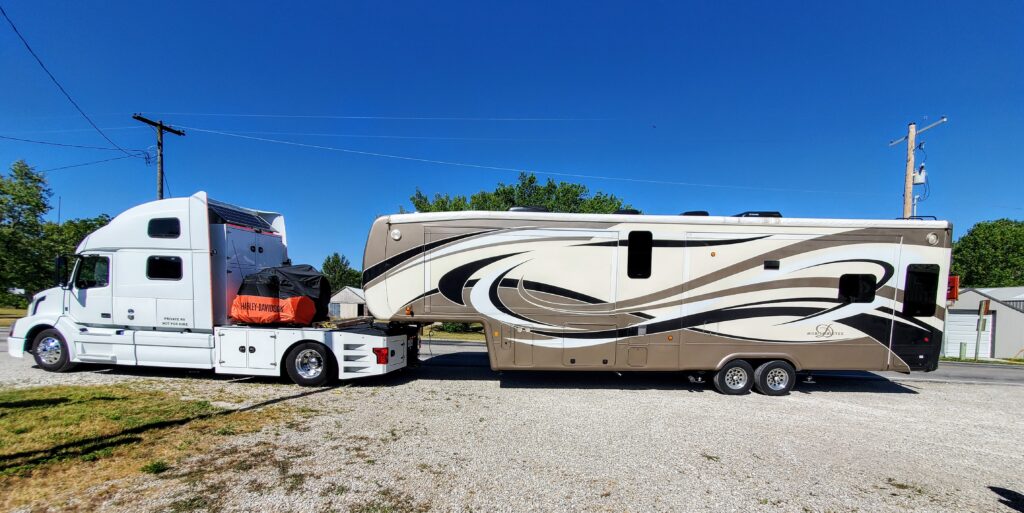
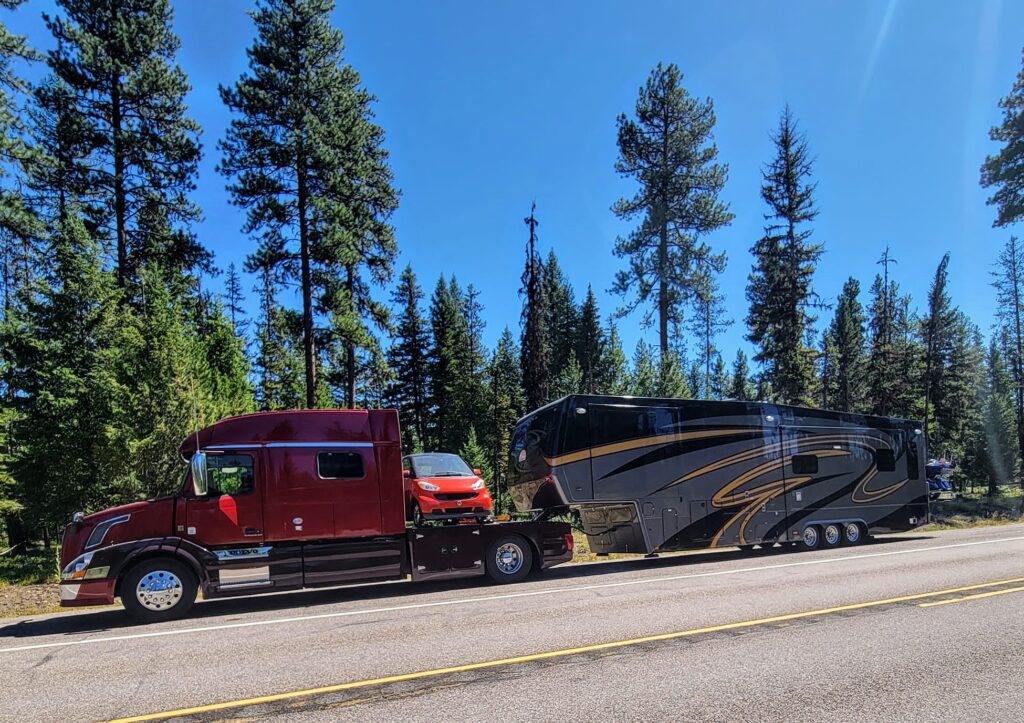
Bed Design Elements
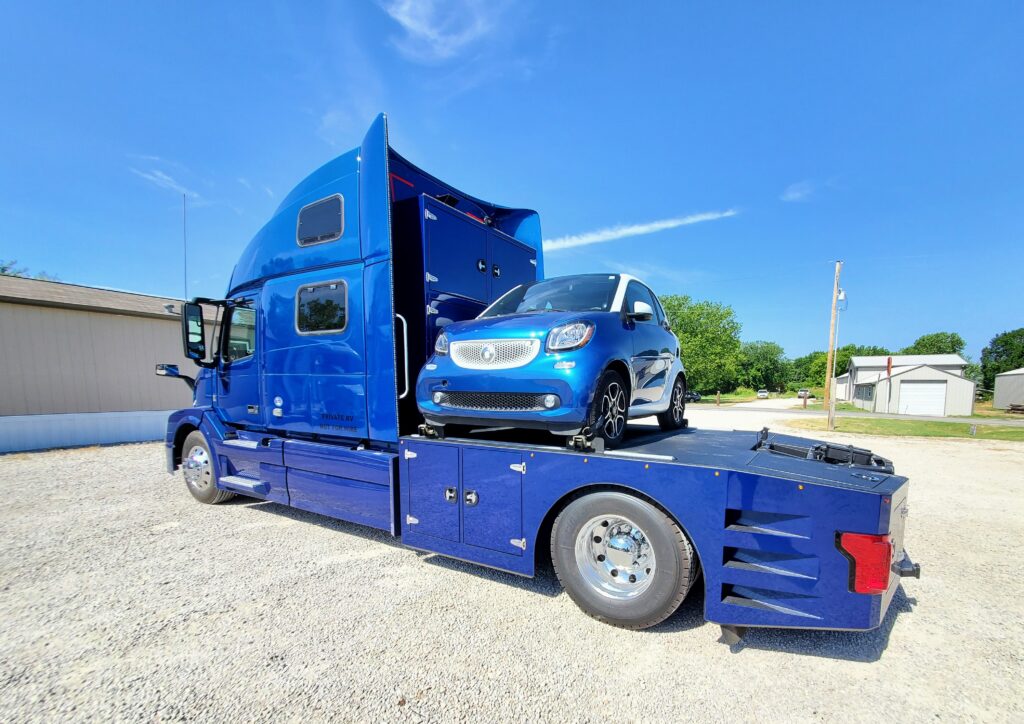
All of the premium bodies look like the one above, as far as basic layout. The gen3 body comes with both the whale tail top boxes and with the under hitch storage. These were both options on the gen2 body. There are no options on the gen3 body that affect the fabrication – the few options that there are on this body mainly deal with minor lighting upgrades or the layout of the utility panel items. Basically, everything is included.
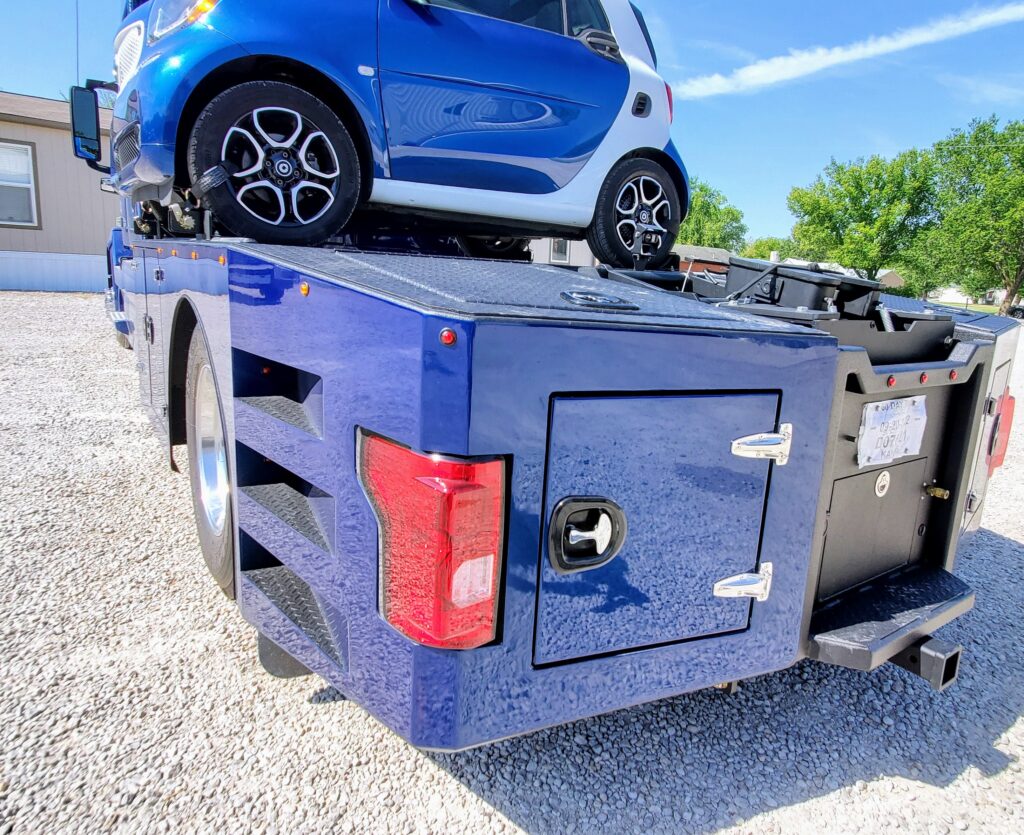
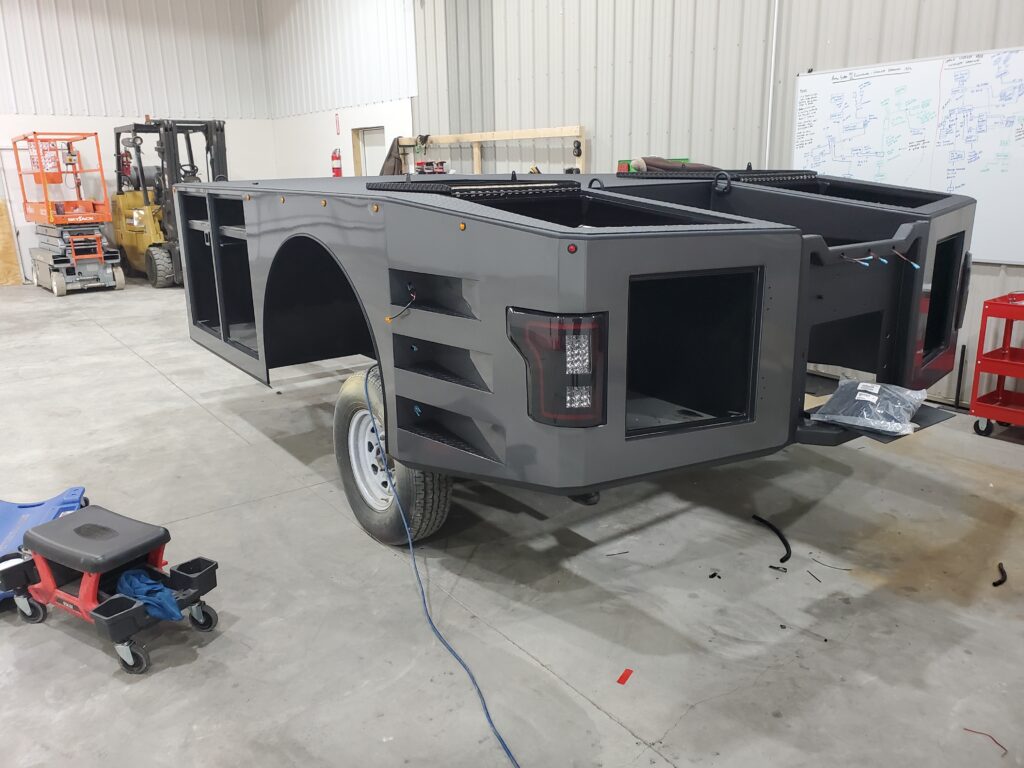
In some cases a “blacked out” light looks better with the body color.
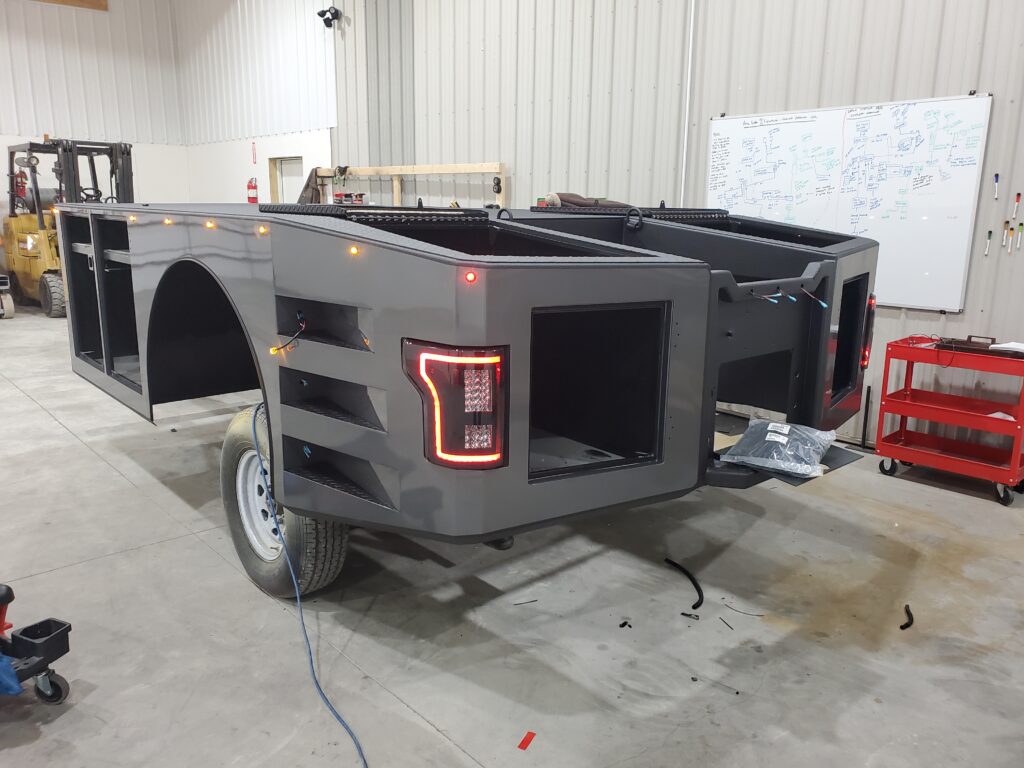
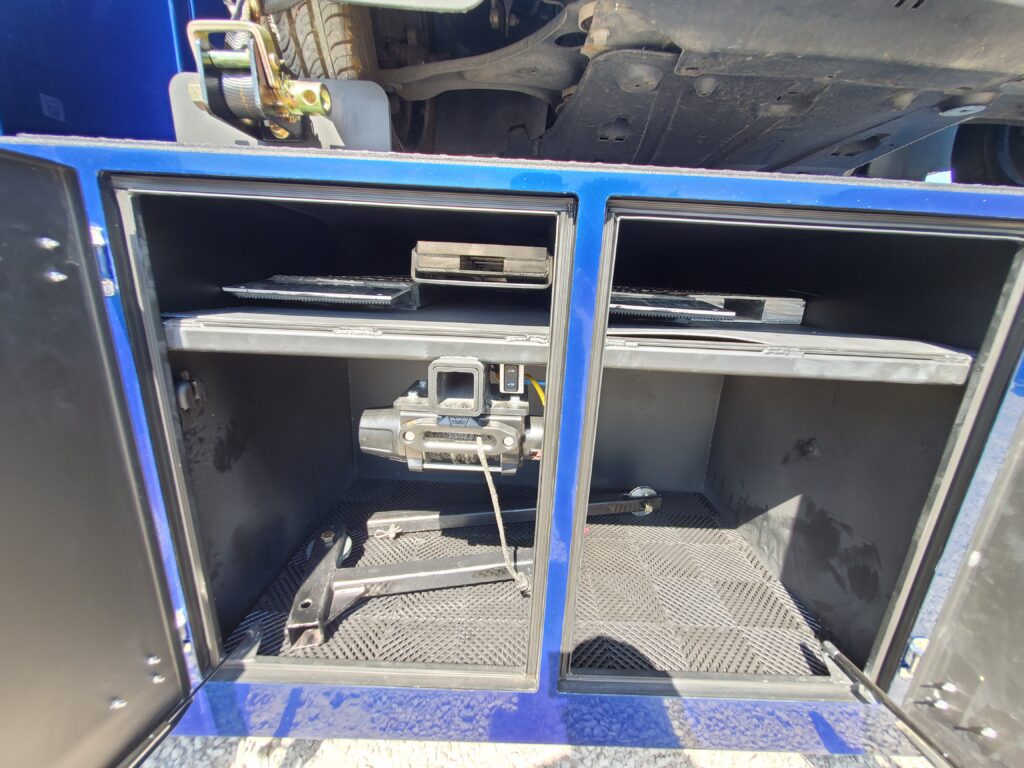
The side boxes have floor liners in them – these protect the floor from cargo, and allow any water that intrudes to be kept separate from the contents. The boxes are water resistant, but no box is perfect. The gen3 body doors are greatly improved over the gen2 body doors – they were completely redesigned, along with the seal system. This same system is used on our sports/utility bed. Check it out in the video below – while the bed looks different, the boxes are built identically.
The doors have standard gas shocks, as shown above.
There are two large pass-thru ramp storage sections that store ramps or other items. For convenience, the ramps can be accessed from either side of the truck. The ramp areas are primarily for 12″ wide smart car ramps. They are fully powder coated inside, and then the floor is lined with an HDPE plastic material. This protects the floor and also makes sliding ramps in and out easier. We put a “rub strip” at the front of the tray to protect the body from the ramps. The ramp storage area will take 18″ wide ramps now, where previously you were limited to 12″ wide ramps.
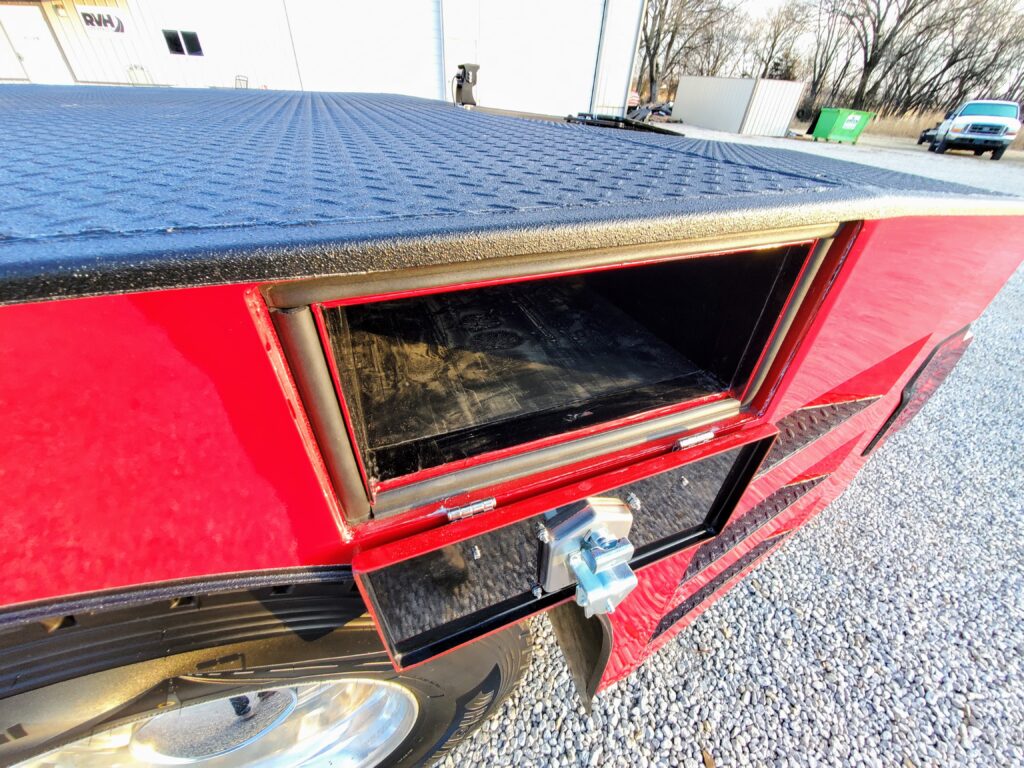
The tail treatment contains integrated “steps” in the side of the bed. While these do function as steps, we consider them mostly an aesthetic element. Marker lights are inside the step area.
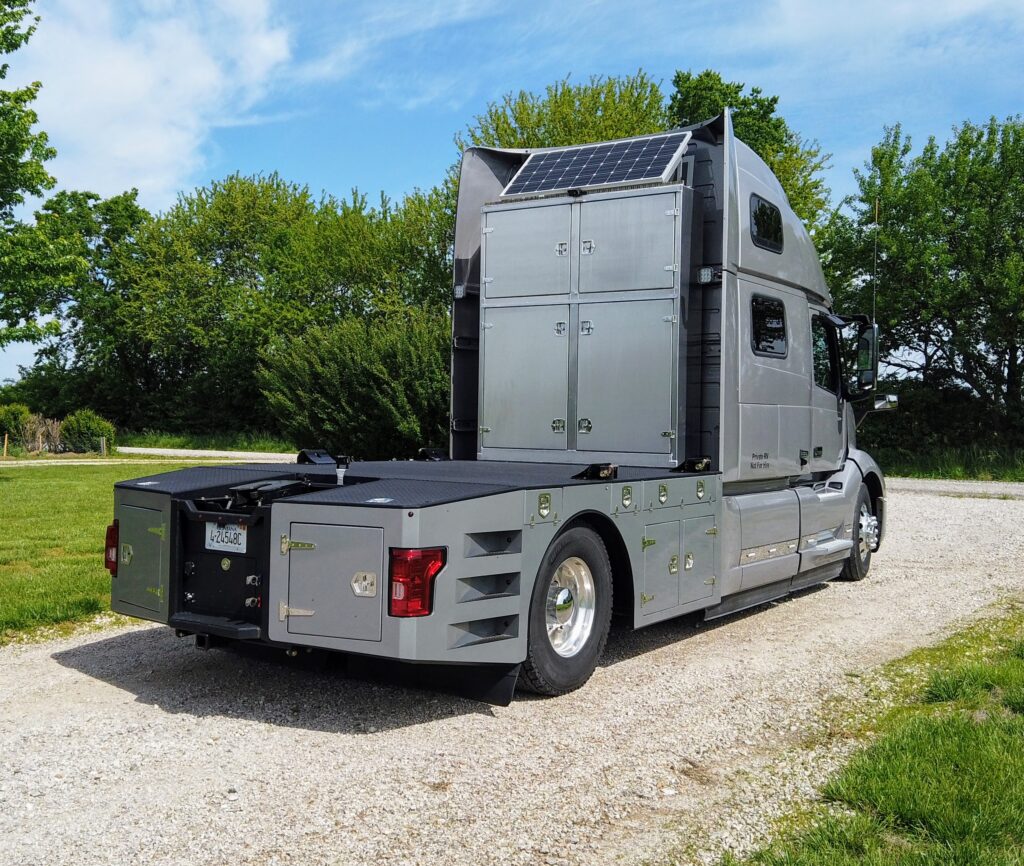
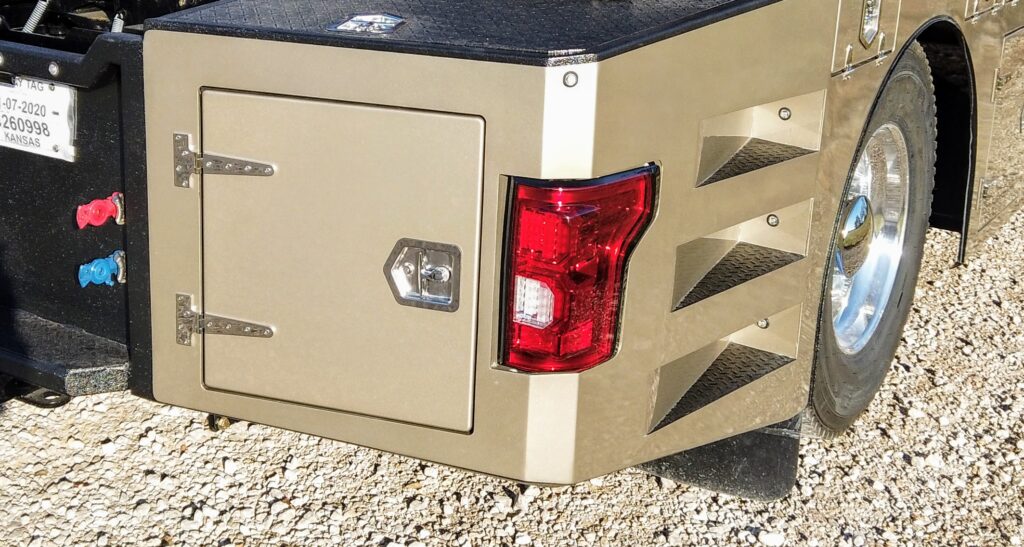
Top boxes that utilize the “dead” area in the rear of the truck lift up. These are called “whaletail” storage. It is a “wet” area, but is perfect for cords, hoses and other small items that don’t mind a little wetness. The gen3 body has drains in the door lips so that most water drains away, but we still consider this a “wet” storage area.
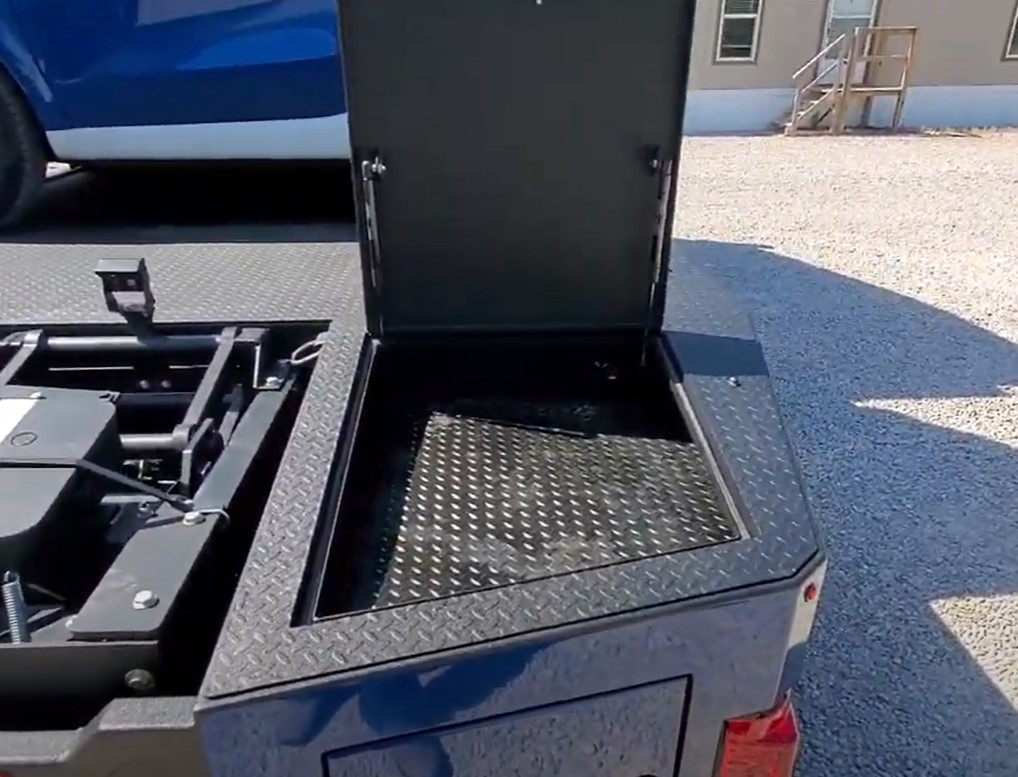
The typical rear treatment is shown below. The center “utility” section is bedlined and contains two or three connectors on the left. In the photo there is a video connector at the top, and the trailer 7-way RV connector on the bottom. Not shown, but available as an option, is an additional 7-way commercial lighting connector (round pins, commercial layout). Both the service line and supply air line are run to the rear. On the right we typically have an air chuck tied to the truck air system. This is useful for airing up the tires on the truck and trailer. We can add gladhands for use with a BluDot braking system on the trailer, if you prefer air/hydraulic brakes.
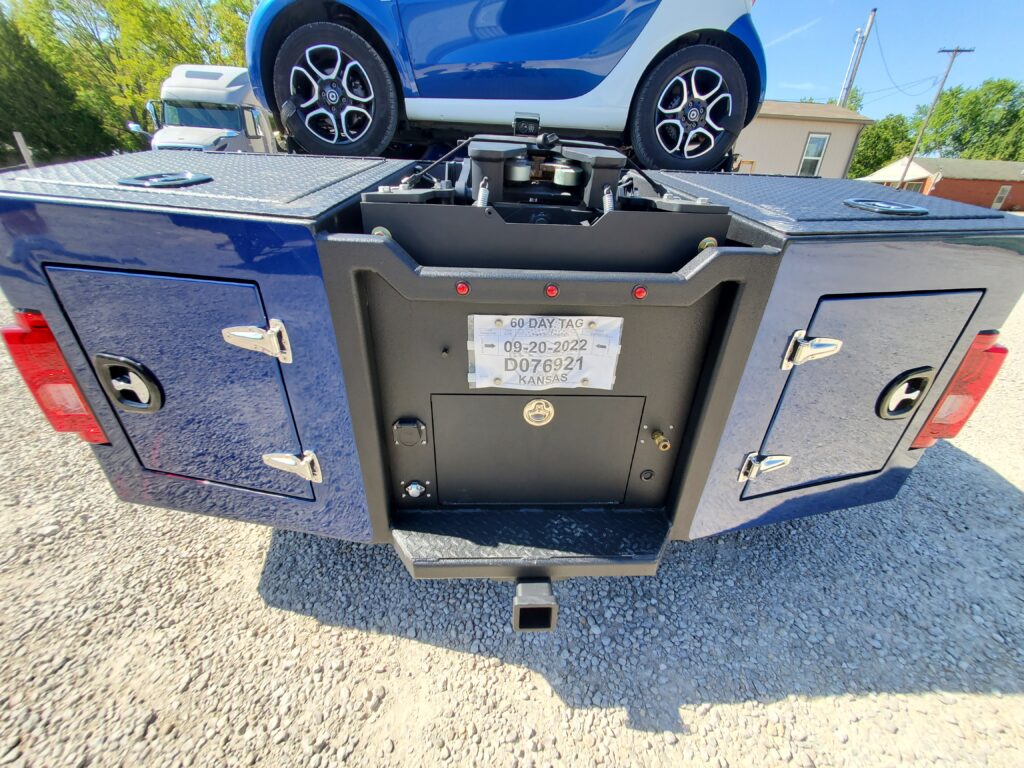
In the center of the rear panel is the door to the standard under-hitch storage. This is wet storage that encompasses the entire under-hitch area. It is perfect for chocks, sewer hoses, blocking or other items that can get wet. The area is enclosed, but not water-tight.
Also note the class five receiver hitch, which is a standard feature of this bed. It is tied to the frame, not the body.
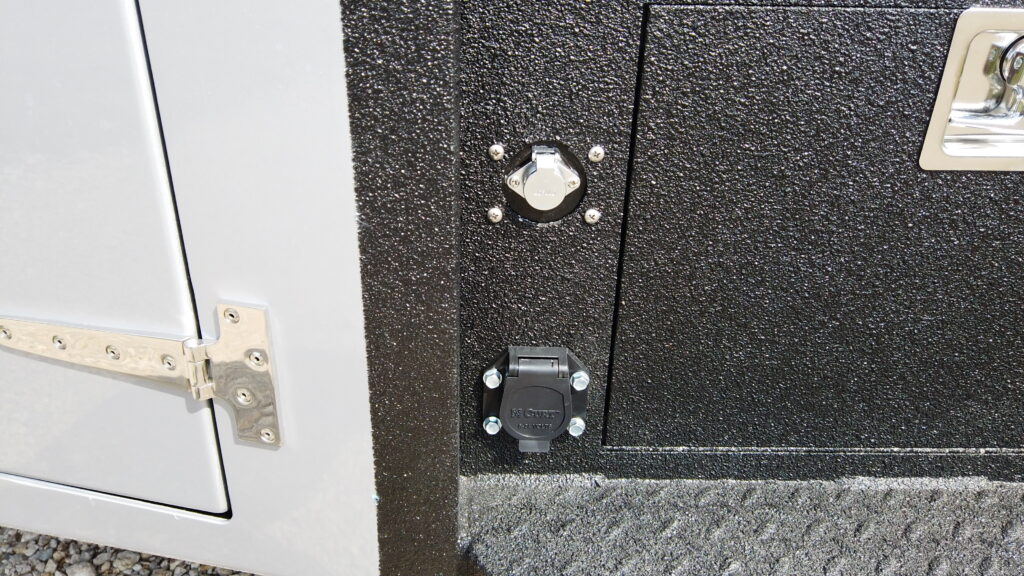
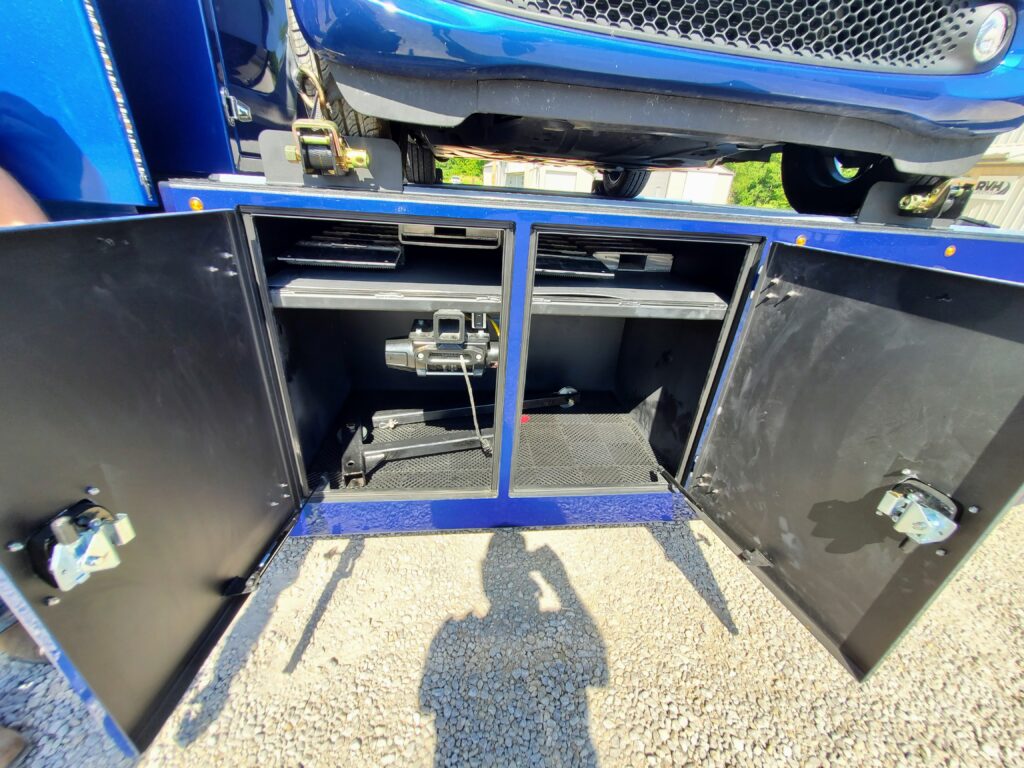
All of our beds have the winch structure built into them. The 4500 lb winch with synthetic line is an optional feature on the drivers side of the bed. It comes with the receiver tube and winch arms. It allows winching on of smart cars, golf carts, trikes, etc. It is optional because some people use loaders or simply do not need/want a winch.
Our L-track based chock and tie down system is available on all of our beds. This system provides adjustment in all four directions making positioning of chocks very simple. The chock system is an option, since not everyone wants or needs it.
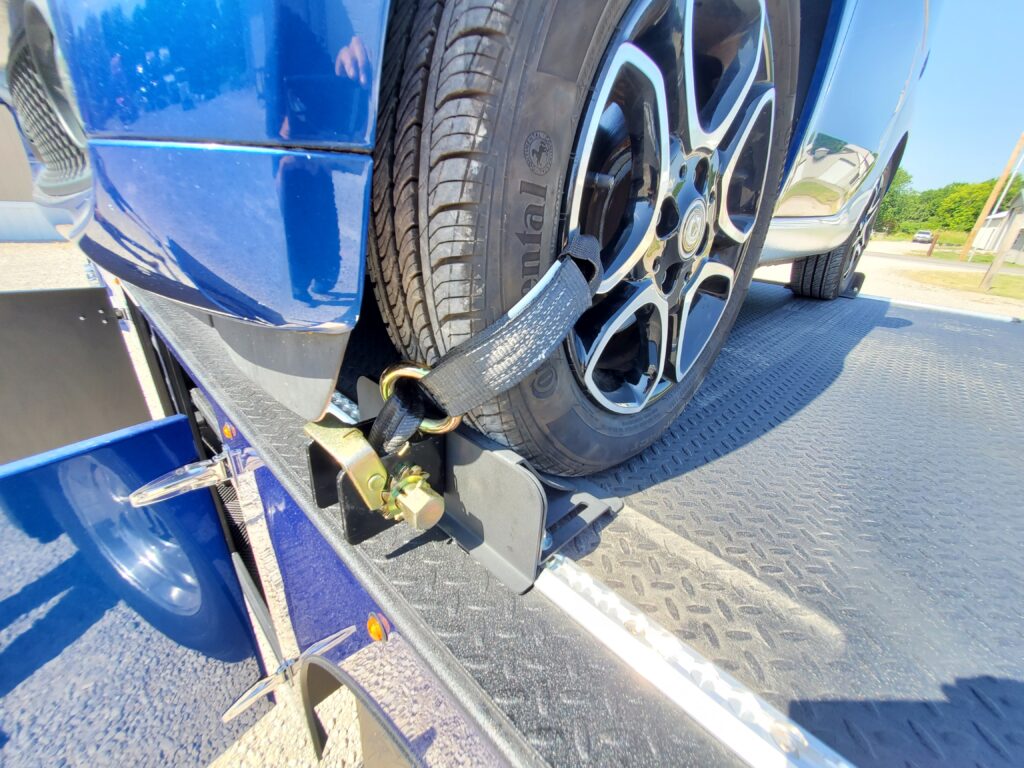
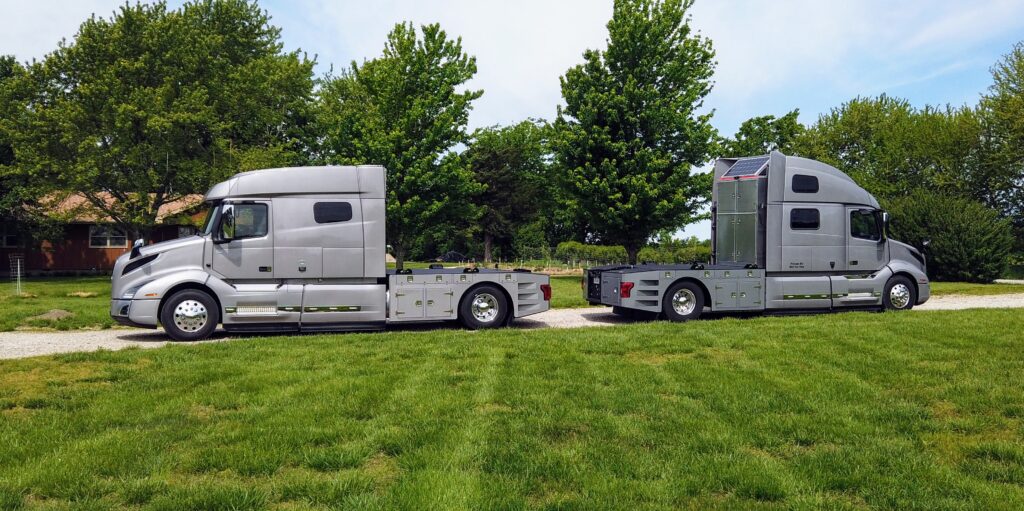
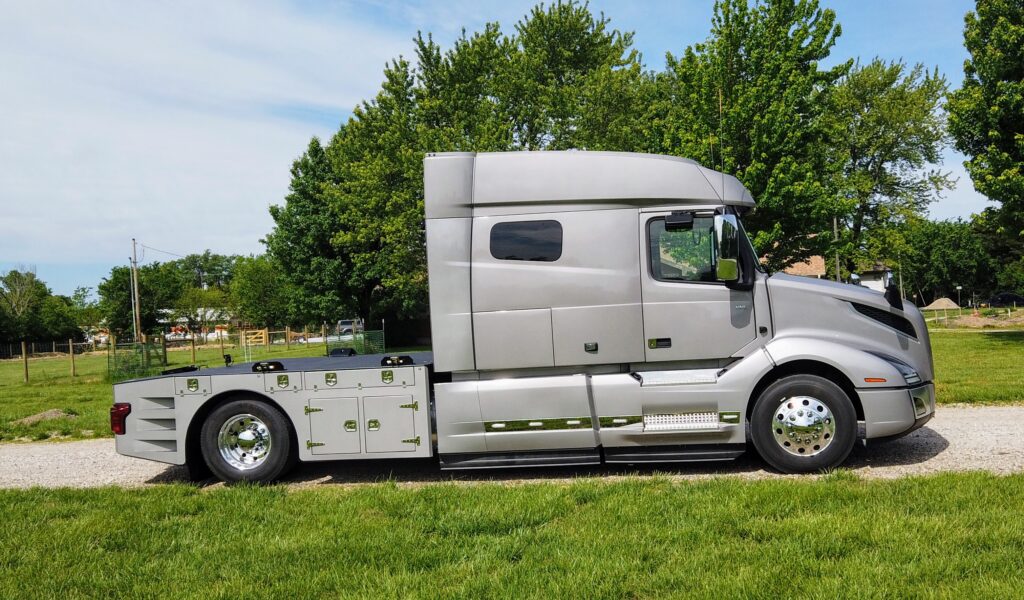
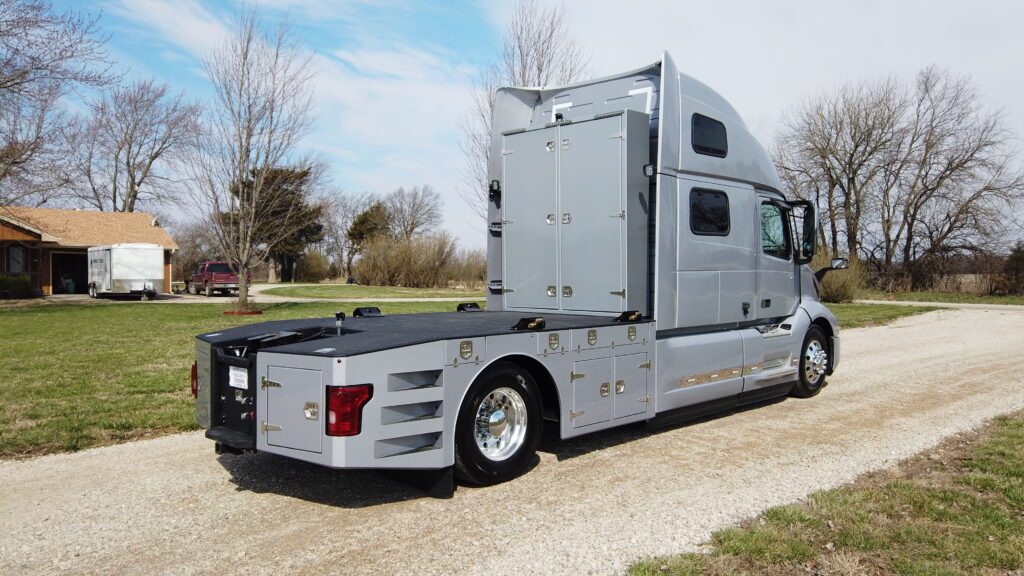
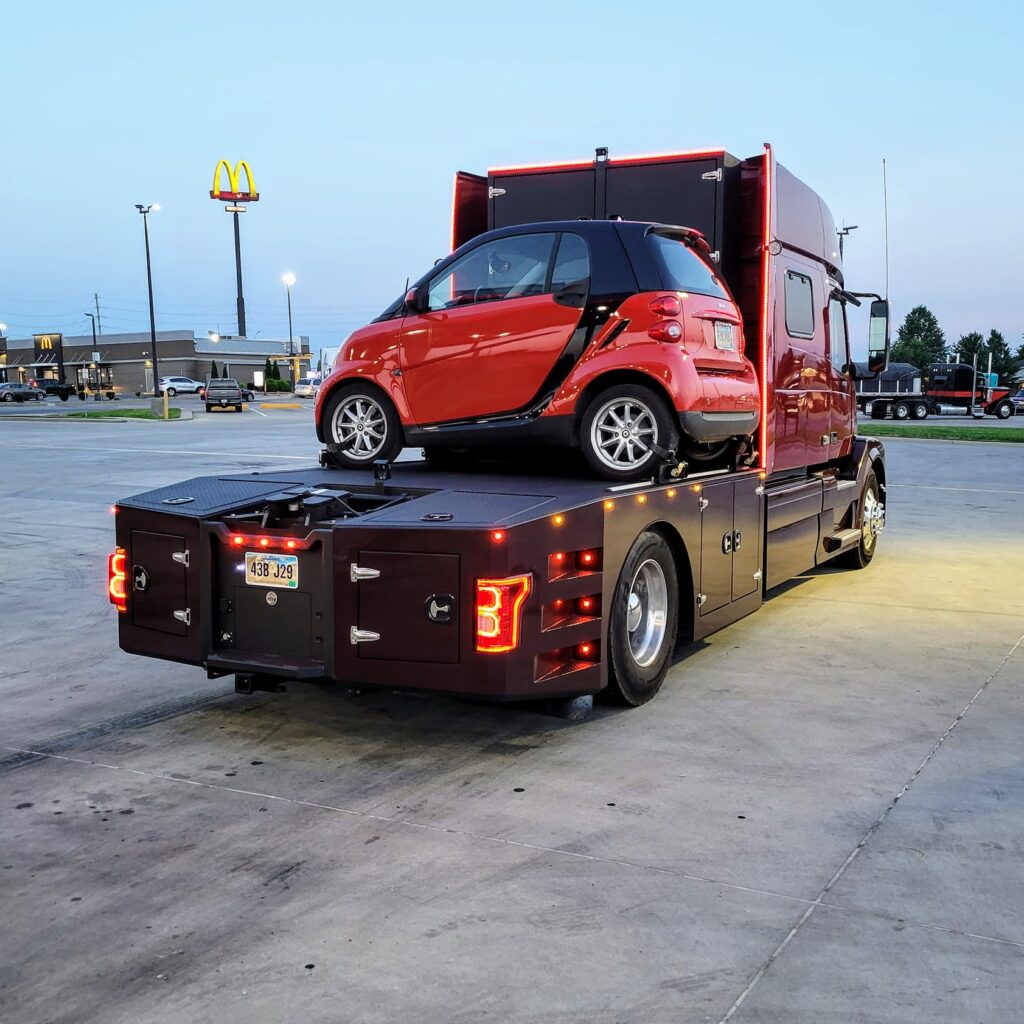
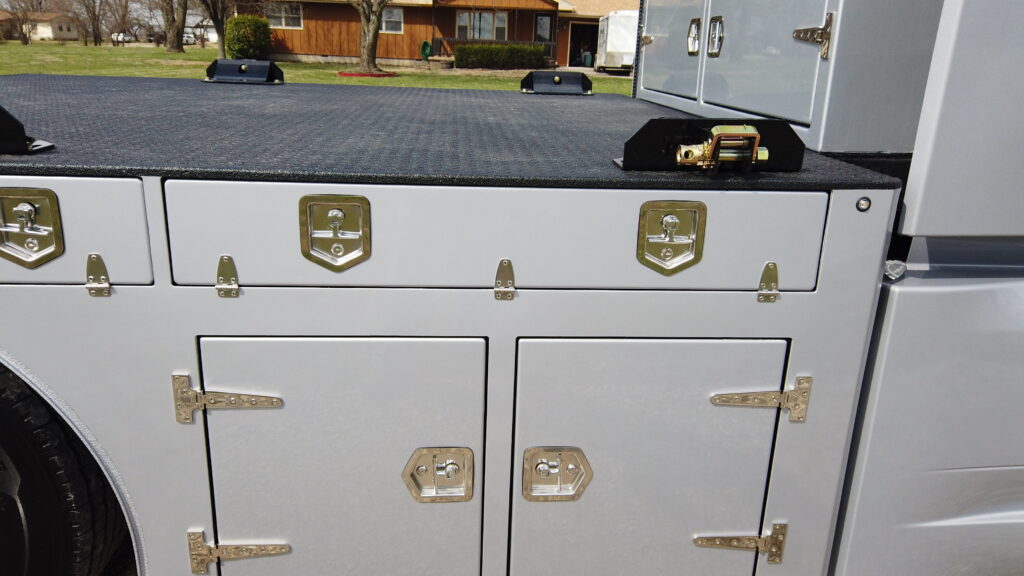
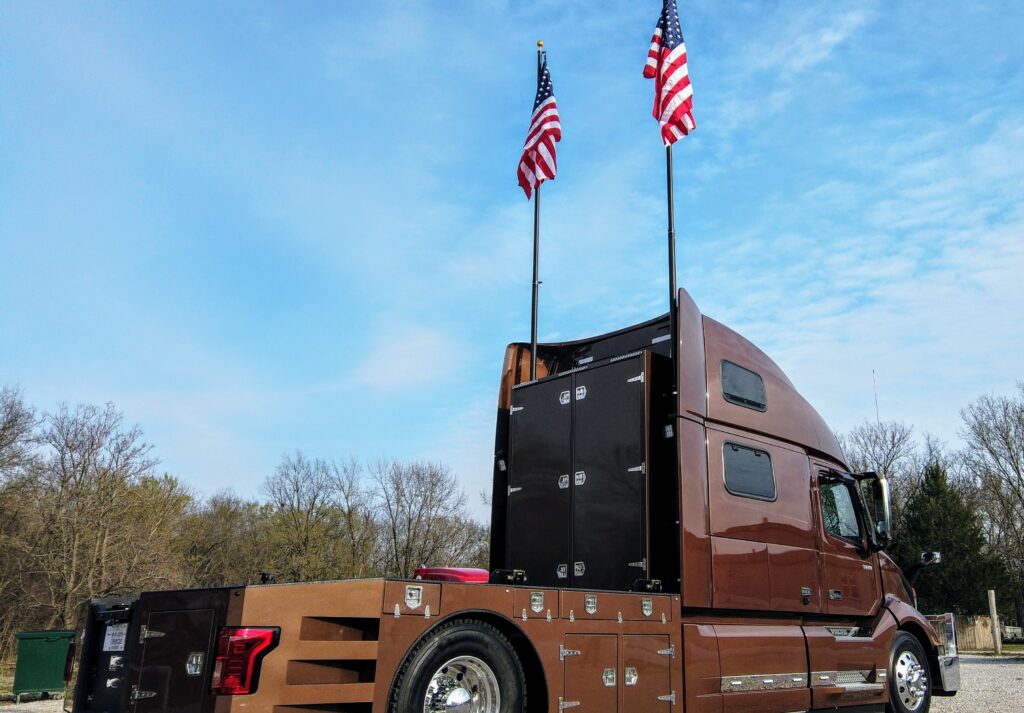
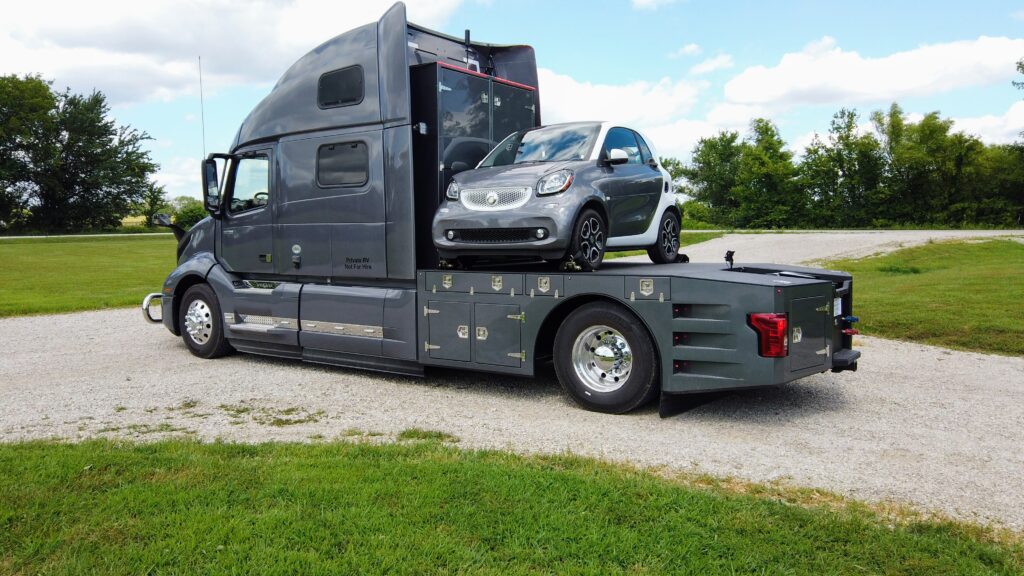
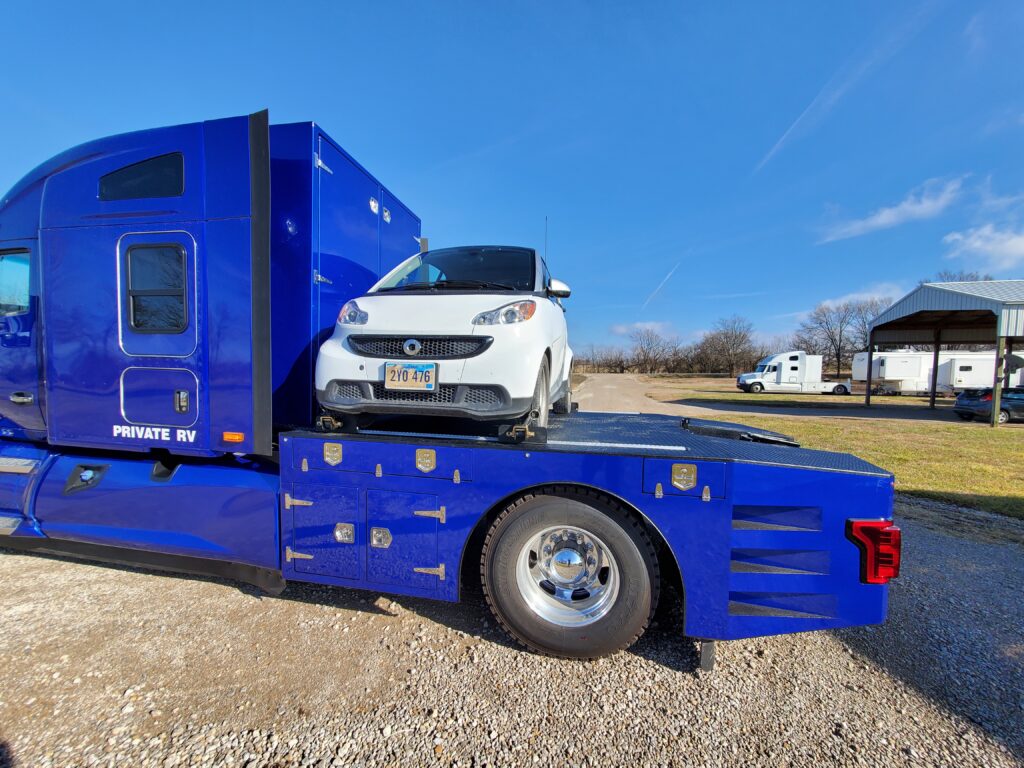
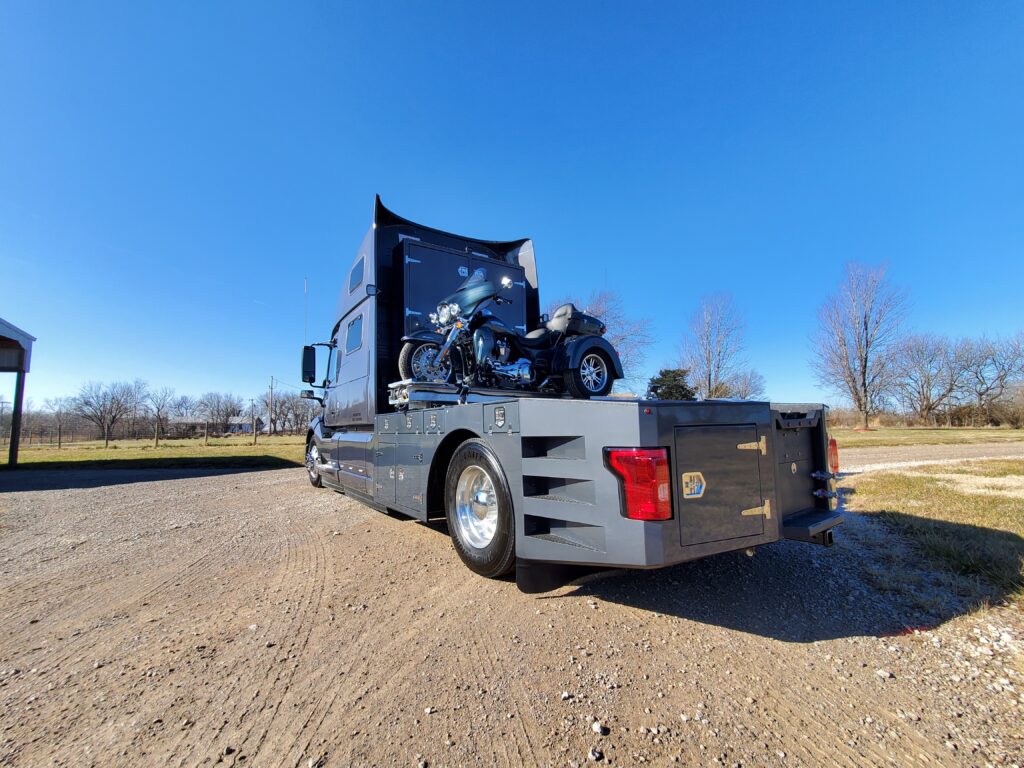
Integration of the Bed with the Tank Fairings
Pre-2019 Volvo trucks have different tank fairing layouts than 2019+ trucks. As well, other brands of trucks have different fairing shapes and structures. Integrating the body with the rest of the truck can be challenging. Not only does each truck brand have different fairings, but even the same year Volvo may have different fairing layouts and types.
When fuel tanks project into the body area, these either have to be accommodated in place, or the tanks have to be moved. In the case of the gen3 body we always either relocate the present tanks, or more typically replace them with smaller tanks (2×100 gallons) and locate them forward of the required body position. Why replace the tanks instead of moving them? Well, we will move them if they are small enough to fit the space, and they do not have serious corrosion on them. However, in at least 75% of the cases the tanks have leaks under the straps due to corrosion and/or debris – thus we replace them.
Relocating or replacing the tanks, and dealing with fairing fit issues are things you should consider when determining what style of bed meets your mission profile and needs/wants. While the cost of doing this is not great, as compared to the entire project cost, it does add up. With the sports/utility bed neither of these issues are considerations – that bed is designed to fit over the tanks.
Volvo 2018 and older
Typically on pre-2019 trucks we move the fuel tanks forward or replace them, and then fabricate a small filler plate to transition from the bed to the fairing. The 2018 Volvo below has a gen3 body on it with the filler plate. This truck had the fuel tanks moved forward instead of replacing them – what we do depends on both cost and condition of the tanks. Note that we also have to adapt the body to the new fuel fill locations. This requires custom fill necks.
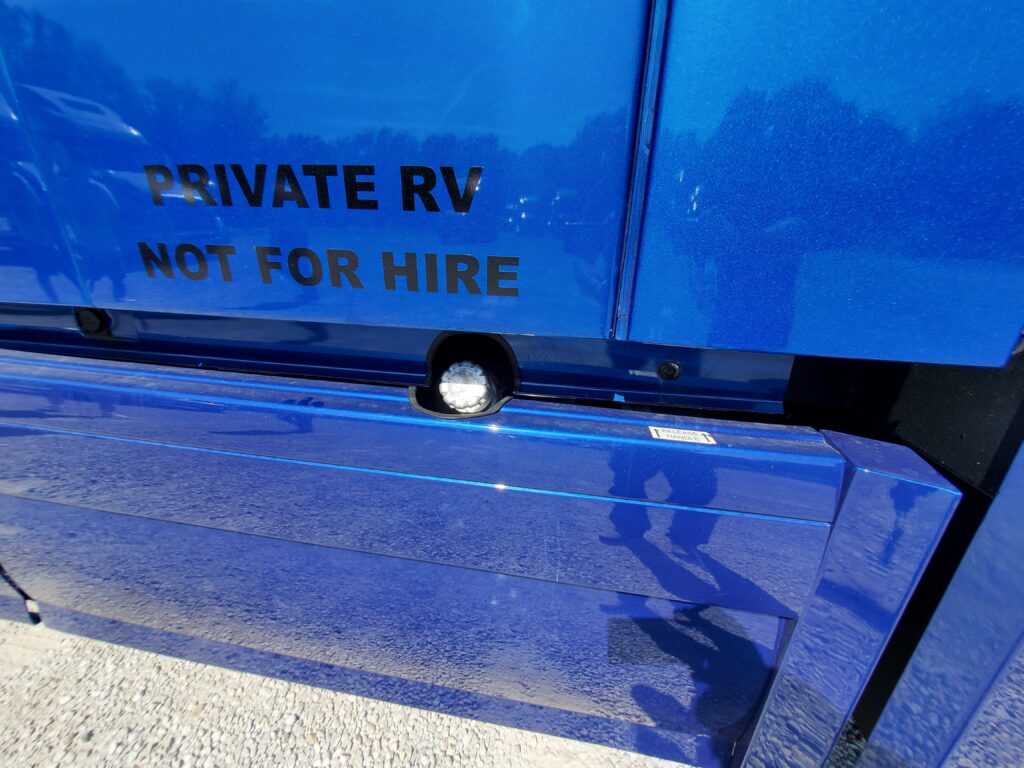
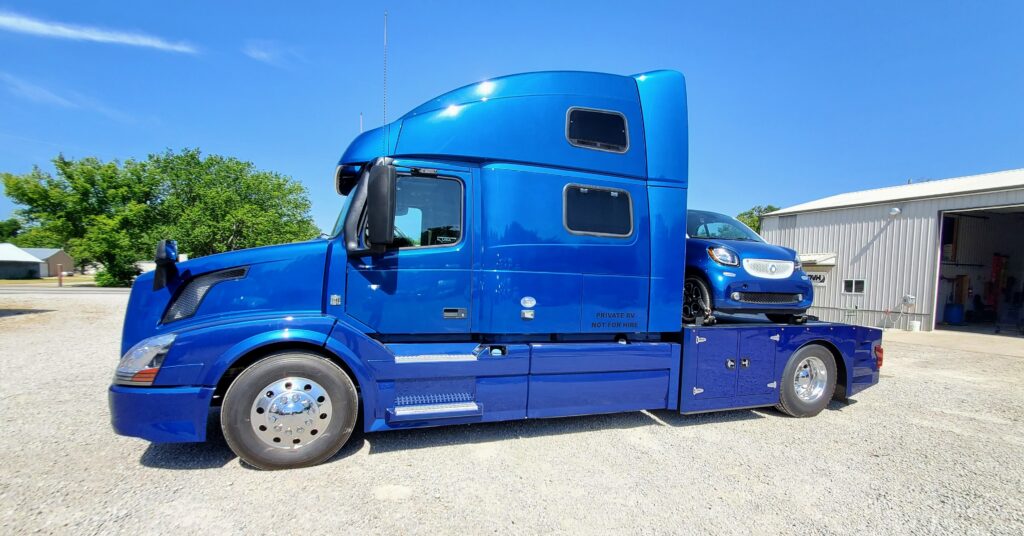
Volvo 2019 and newer
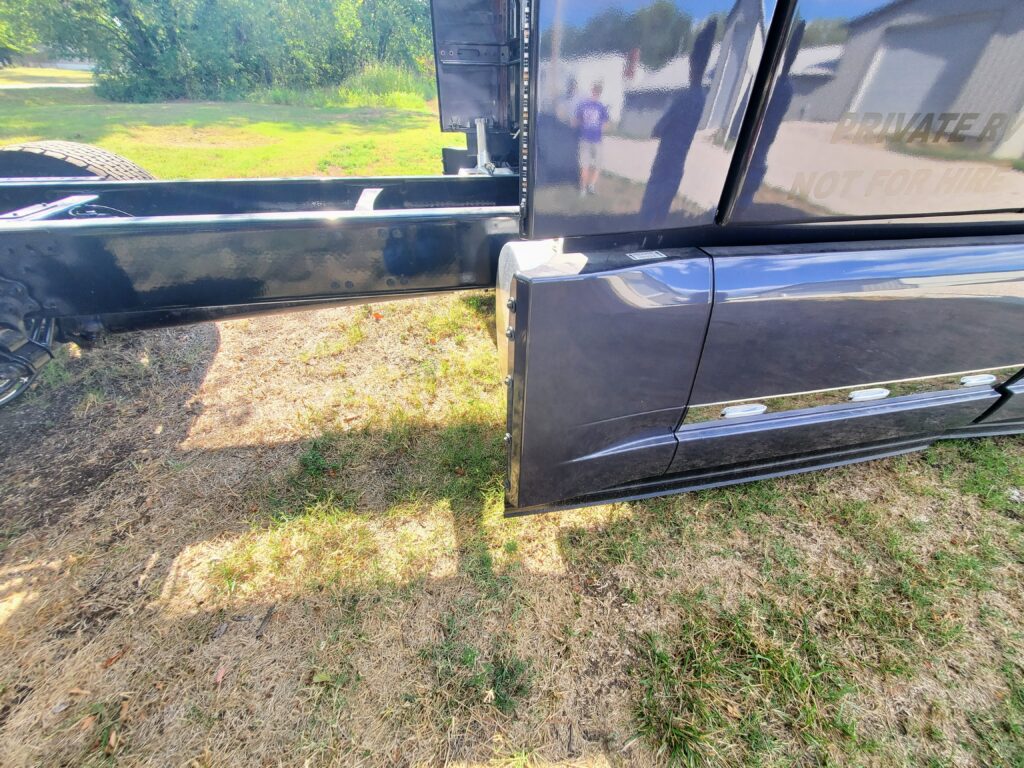
When we order a new truck we specify the tank location and size – thus avoiding any bed interference or adaptation issues. We also specify the style of fairing that we want so that it integrates well with the body for a cohesive look.
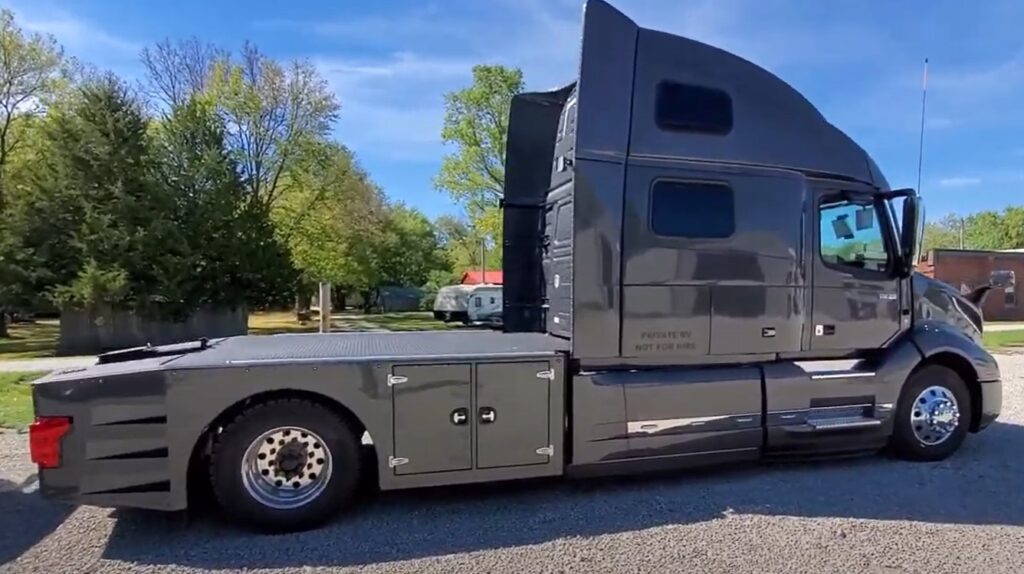
Used Volvo’s that are 2019 and newer will not come with a fairing like we order (above). They typically come with a step fairing, and a tank fairing that stops short of the vertical cab fairing – as shown below. Moving the tanks and eliminating the step fairing results in a “void” in the fairing line. Note that the fairing ends are also angled on the new body style. This is a challenging problem to solve.
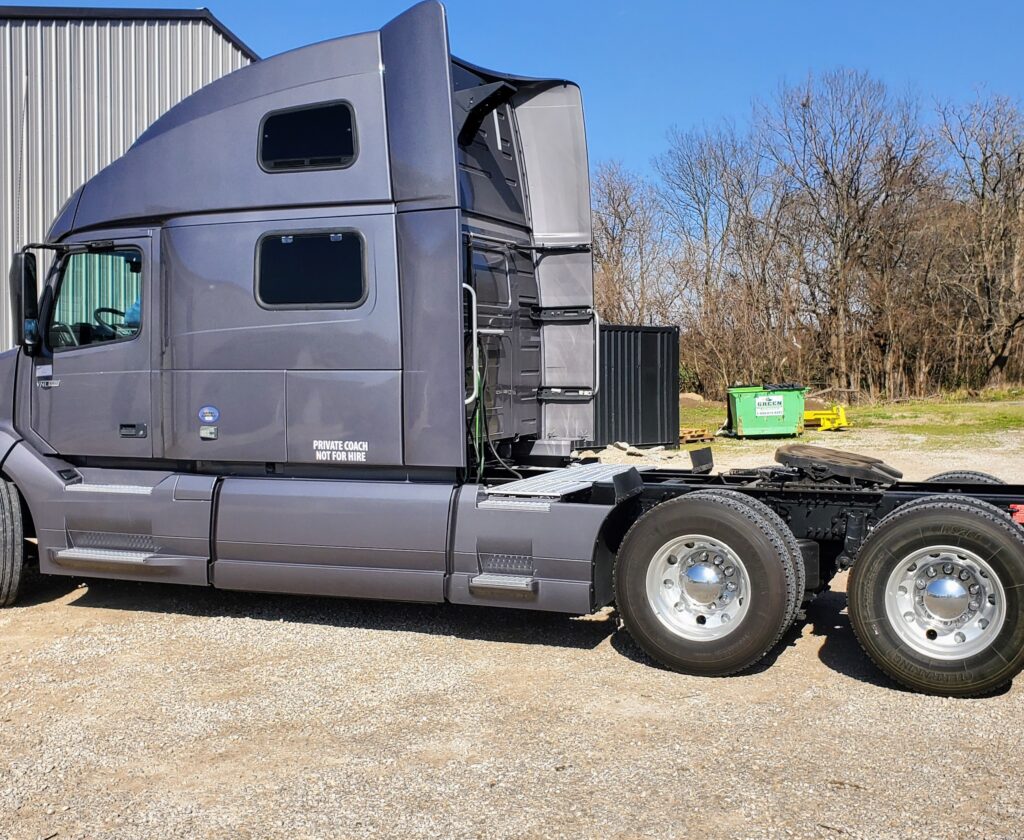
While we can order replacement fairings and brackets to duplicate the look and function of our “new order” trucks, this is a very expensive solution – on the order of $7500 for both sides just for the parts. Then add labor and paint. It does give you the look of the ordered truck, though. We can also search for used parts – although these are difficult to find. In the end, used is usually not a viable option because of that.
The solution we typically use is to modify the step fairing and use it as a filler for the gap that would otherwise be present between the truck fairing and the body. While this is not an ideal solution, it is acceptable to most, and the modifications are a much more viable solution cost-wise.
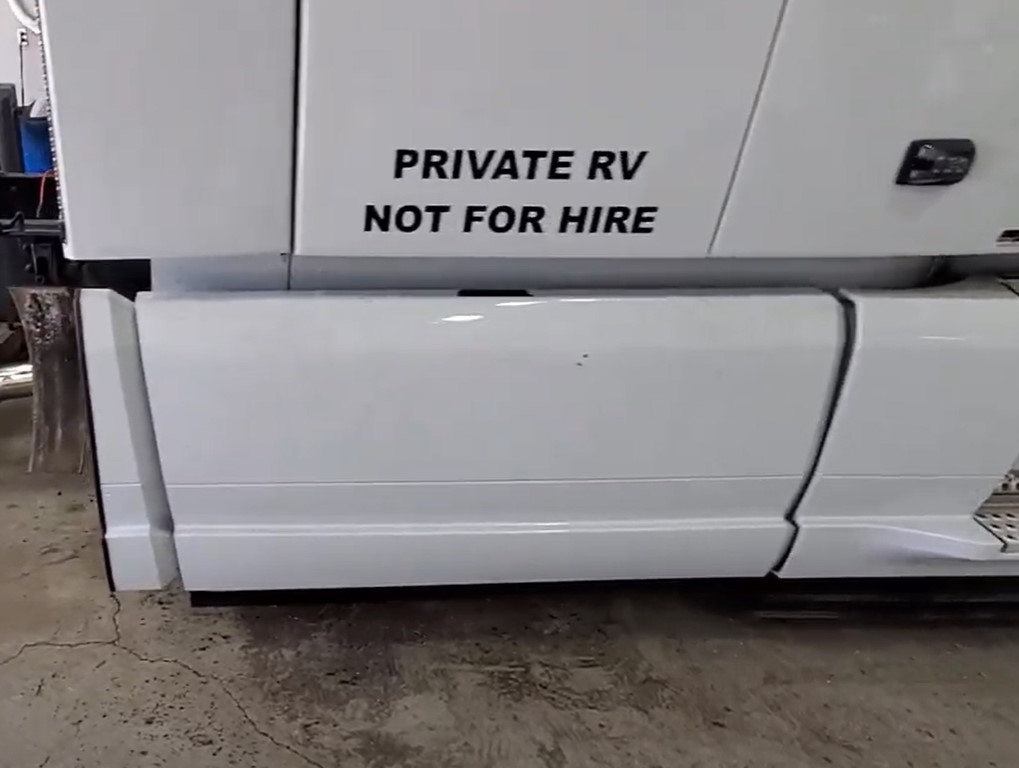
Non-Volvo Trucks
How we handle the fairing transition on non-Volvo trucks depends on the particular brand, and the layout of both the tanks and fairings. We need to know these details before building the bed, because it is typical that we have to make modifications based on the truck configuration.
